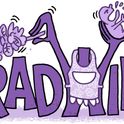The name triggers a cascade of impressions. Einstein: the shock-haired and sockless genius, avuncular symbol of pure intellect, head in a whirlwind of equations and galaxies. Scientist, sage, ambiguous pacifist, lousy husband, negligent father and now, what's left of him, fragments of brain in a jar.
Not long after Einstein's death, in 1955, Roland Barthes called his brain a mythical object, a paradoxical conflation of man, magic and machine. Nearly 50 years on, the myth remains potent. To look at any brain is to confront a deep mystery. The brain can't be the theatre of consciousness-it's a solid object -and yet it must be because you are contemplating the scene on the floodlit stage in your own head. But looking at the photographs of Einstein's brain, snapped in the interlude between extraction from the cranium and decimation at the hands of Princeton Hospital's duty pathologist, Thomas Harvey, you feel the pull of myth as well as mystery. It is difficult not to see the object as a sacred relic.
There was speculation about the brain from the start: it was huge and strange, and then again it was mysteriously tiny, the size of a walnut. In fact, it looked ordinary and weighed 2.7 pounds. About average. It was removed within seven hours of death, weighed fresh, then fixed in formalin. After it had been photographed and measured with callipers, the cerebral hemispheres were separated and diced into 240 blocks. Then the brain disappeared. Soon after the autopsy Harvey announced that it would be used for research. But he simply took the pieces home with him and stored them in cookie jars. Never mind his lack of qualifications for the job (he was a pathologist, not a neuroscientist) he would be the one to unlock the secret of Einstein's brain.
The pathologist was accused of a smash and grab exercise, although he always maintained he'd acted on the authority of Einstein's executor, Otto Nathan. Nathan called him a thief and he eventually left Princeton, allegedly fired for not relinquishing the brain. But he hung on to his cookie jars. In 1978 he was tracked down by a journalist, Steven Levy, working for the New Jersey Monthly. Levy found him in Wichita. The remnants of Einstein's brain were in a box marked "Costa Cider."
Two decades later, another journalist turns up: Michael Paterniti. The Keeper of the Brain is now in his eighties and living in a basement back in Princeton. Together they set off for California in a rented Buick with Einstein's brain floating in a Tupperware container. Paterniti wants to explore rumours that it might be cloned, or sold to Michael Jackson, but Harvey isn't saying much. They end up at the home of Einstein's granddaughter, Evelyn, who seems less in awe of the relic than anyone else. As described in his book, Driving Mr Albert, Paterniti's own reactions are complex. "I never thought that, holding Einstein's brain, I'd somehow imagine eating it," he says at one point. Then, at a seedy motel on the way home, he sleeps with it-"I go to bed. I put Einstein's brain on one pillow and rest my own head on the other next to it, six inches away."
What about the science? Was Einstein's brain extraordinary? Despite Harvey's pledge, no study appeared for three decades after the autopsy. By now he had begun to mail bits of brain to prominent neuroscientists, people better placed than he to examine the material. Marian Diamond's four sugar cube-size pieces arrived at her Berkeley office in a mayonnaise jar. Examining the specimens, she found an unusually high ratio of glial cells to neurons in the inferior parietal lobe, an area known to be associated with mathematical and spatial reasoning. As for overall anatomy, the first study appeared in 1999. Sandra Witelson, of McMaster University, had received, unsolicited, a package of brain pieces which she and her colleagues set about measuring and comparing with other brains. Again, the inferior parietal lobe stood out as different, being 15 per cent larger than normal.
Such observations have been dismissed as no more than bump-reading phrenology. But Einstein would not have objected. He was game for a laugh. And the bump at least has a plausible location given his mathematical prowess and what we already know about the organisation of brain functions. It is something. There's a story here.
Some years ago my young son and I were in a shoe shop in Cambridge when in came Stephen Hawking in his motorised wheelchair. Like Einstein he has come to symbolise pure intelligence. The shining mind in the shrivelled body. There was a woman helping him and they were looking at a rack of cheap trainers. He didn't seem very interested. My son went close up and stared and I expected him to say something indiscreet. But he lost interest. The trainers he was eyeing were a cut above Hawking's. He was not impressed, though I felt peculiarly touched. This was the man who visited black holes from his wheelchair. He did so in Tru-Form trainers. Barthes would have liked that.
Now Einstein's brain is back at Princeton Hospital. Actually, not as such. It has a new Keeper, one Elliot Krauss, pathologist. He keeps it in a jar somewhere secret.











